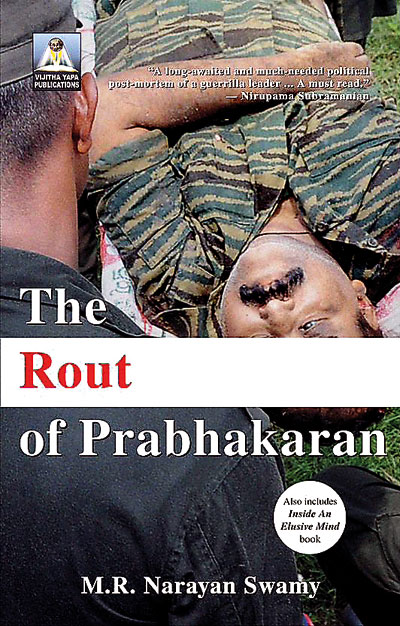Sunday Times 2
Fresh insights into the war
View(s):- Review: The Rout of Prabhakaran by MR Narayan Swamy. 432 pages published by Vijitha Yapa Publications Rs 4950
By Padma Rao Sundarji. Hindustan Times New Delhi

A myriad stories shroud Velupillai Prabhakaran, chief of the Liberation Tigers of Tamil Eelam (LTTE). 16 years after he met his gory end, veteran journalist MR Narayan Swamy’s (”MR”) fourth book on the Sri Lankan civil war, The Rout of Prabhakaran, provides fresh insights into the man whose megalomania proved to be his nemesis.
Reporters covering a multilayered armed conflict often risk being bitten by the journalistic equivalent of the Stockholm Syndrome. MR nimbly sidesteps that danger and remains firmly centered throughout, beginning with his opening description of the most controversial final stage of the war in May 2009, for which the Sri Lankan Army (SLA) still faces international censure for the alleged slaughter of 40,000 Tamil civilians.
The author is unambiguous and points out that the civilians moved towards – not away from – the SLA, while their “Sun God” Prabhakaran, tried to escape, using them as human shields:
“The LTTE had created a bund… partly to prevent civilians from escaping”…“Once the troops managed to dent these… thousands… began to stream towards the government soldiers… This… dramatically brought down the number of civilians in the battle zone,” MR writes.
His revelations about Mahinda Rajapaksa, Sri Lanka’s most popular former president, who was in power at the time, will also be a blow to armchair critics. After 30 years of civil war, the hardline Sinhala politician ended the conflict by ignoring western interference, that had earlier forced repeated ceasefires upon the SLA. Those ceasefires had allowed the LTTE to replenish weaponry, recruit more child soldiers and teenage suicide bombers, and launch fresh attacks.
The author writes that Rajapaksa told peace negotiators that he recognized Tamil grievances as genuine and was willing to talk to Prabhakaran and name him the de facto ruler of North and East Sri Lanka, provided the LTTE laid down weapons. And that if the Tiger chief contested a democratic election, he would even be named the prime minister of Sri Lanka.
The LTTE chief’s obsession with numerology, his quoting the Bhagavad Gita for killings, his nonchalance about murdering Sinhalese children “because they would grow up and kill Tamils anyway”, his delusionary refusal to believe that he was losing the war: there are many interesting new insights into the school drop out who took to weapons early in life.
“Prabhakaran’s persona became… in some ways”, (the LTTE’s) “greatest weakness. In that sense, he was like Osama bin Laden,” writes MR.
The book offers chilling details of how the LTTE drove Sri Lanka’s Tamil-speaking Muslims out of the island’s northern and eastern areas and looted their properties, how Tamil teens were brainwashed to swallow cyanide capsules or, blow themselves up in suicide vests. The story of 14-year-old Selvarasa Rasasekaran, whose best friend was killed when Sri Lankan soldiers opened fire from a passing train and whose grief made him join the LTTE, is a tragic reflection of a similar tale on the Sinhalese side – of monk-turned-soldier, “Hasalaka Gamini”, who took a shower of bullets to save his brigade.
“A time came when deaths appeared to lose all meaning: they simply turned into mass statistics and inanimate memorials,” MR writes. He does not mince his words about the dubious roles played by India, the West and former Sri Lankan president Ranasinghe Premadasa in the conflict. India trained and hosted the LTTE: Prabhakaran was a state guest at New Delhi’s Ashok Hotel. But even after the LTTE began killing rivals on Indian soil, former PM Rajiv Gandhi naively rejected warnings. He gave money to the group and even gifted Prabhakaran a bullet-proof vest. Years later, he would be assassinated by a woman Tiger in a suicide vest. The Indian Army’s brief and unsuccessful stint as peacekeepers in Sri Lanka also saw India controversially “rewarding” LTTE fighters with ‘freedom and a flight to the West’, in exchange for information, the author discloses.
There was a “cynical nexus” between former Sri Lankan president Ranasinghe Premadasa – whose son, Sajith, narrowly lost last month’s presidential election – and the LTTE. MR describes how Premadasa supplied arms and ammunition to the LTTE to fight the IPKF, which had been invited by Premadasa’s predecessor, and had generated much public anger against Colombo. When the IPKF left, Premadasa turned the heat back on the LTTE. It retaliated predictably – by assassinating Premadasa himself.
The author is critical of the powerful Tamil diaspora and how it ignored forcible child recruitments by the LTTE – which it armed and funded – in faraway Sri Lanka, while its own children lived in safety in the west. Given the current fracas between Canada and India, MR’s narrative about Ottawa’s indifference to LTTE terror on its own soil, will ring a loud bell.
Veteran Sri Lankan Tamil journalist and Prabhakaran-critic, DBS Jeyaraj, was brutally attacked with baseball bats in a Toronto park. Nobody was arrested, nor prosecuted. MR details more instances in France, Germany, Australia and the UK, where there were arrests. All these countries are home to sizeable populations of Sri Lankan Tamils, including LTTE sympathizers. “Would (these countries) have acted thus if the LTTE had killed a President or PM of a western country?” asks the author.
MR is largely kind to the Norwegian mediators in the Sri Lankan civil war, in which 130,000 people were killed. But their role – stemming more from ambition to play global peacemakers than philanthropists – doesn’t seem illustrious either. In a last-minute attempt to get Prabhakaran to lay down arms, described in some detail in the book, Oslo itself seemed afflicted by Stockholm Syndrome: the mediators first tried to “provide comfort” to Prabhakaran, a wanted terrorist, by pandering to his refusal to ‘surrender’ and euphemistically calling it “an ‘organized end to the war” instead. “Even as he went down fighting, Prabhakaran refused to clutch a long rope the Norwegians tried to hurl at him. If (Prabhakaran) had caught it, it is possible that he may have survived the war… and… spared the lives of Tamil civilians who perished in the bloodbath for no fault of theirs,” writes MR.
This frank submission on Norway’s desire to “save” a proscribed terrorist, primarily shows how much of the responsibility for the bloodbath lay with Prabhakaran himself. One western diplomat told MR that if Prabhakaran surrendered, the “overwhelming bulk” of the LTTE would be placed “under Sri Lankan custody”, while the “top LTTE leaders…with their family members”, would be whisked away “to a third country minus weapons,” where – runs the bizarre surmise – the LTTE’s murderous leadership would live happily and peacefully ever after.
Why did Norway preposterously throw a “long rope” to Prabhakaran?
How could the West assume that a “third country” would welcome the LTTE with open arms? Why didn’t it offer a home to them on its own soil instead?
MR Narayan Swamy is a masterful authority on Sri Lanka. He will surely provide answers in his next book.
Padma Rao Sundarji is a veteran foreign correspondent and author of Sri Lanka: The New Country (HarperCollins, 2015).

